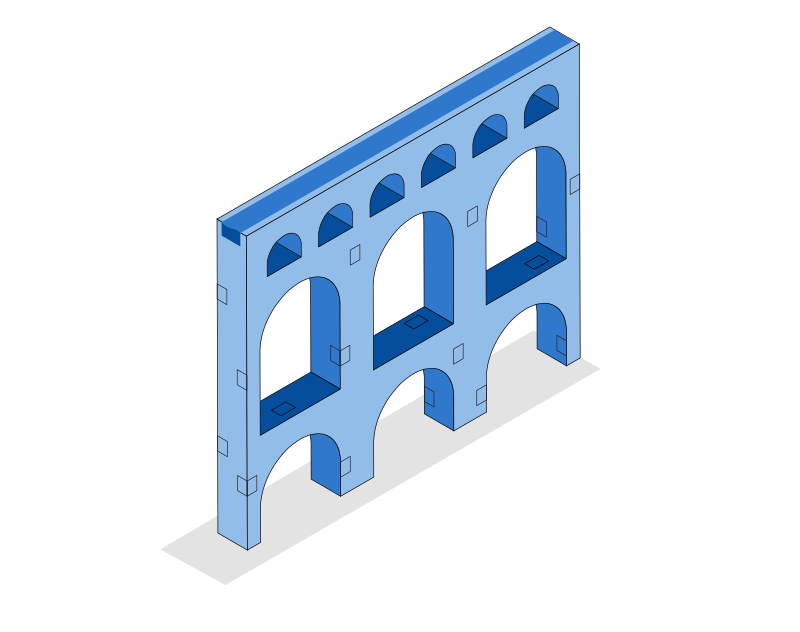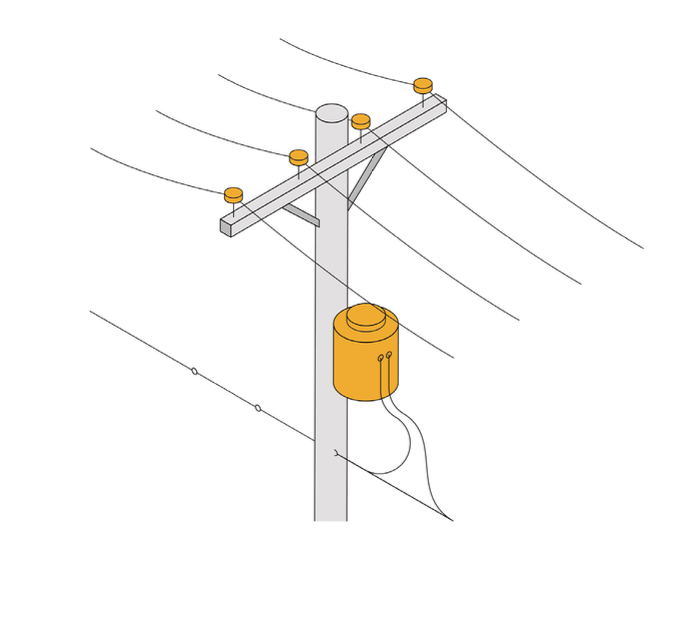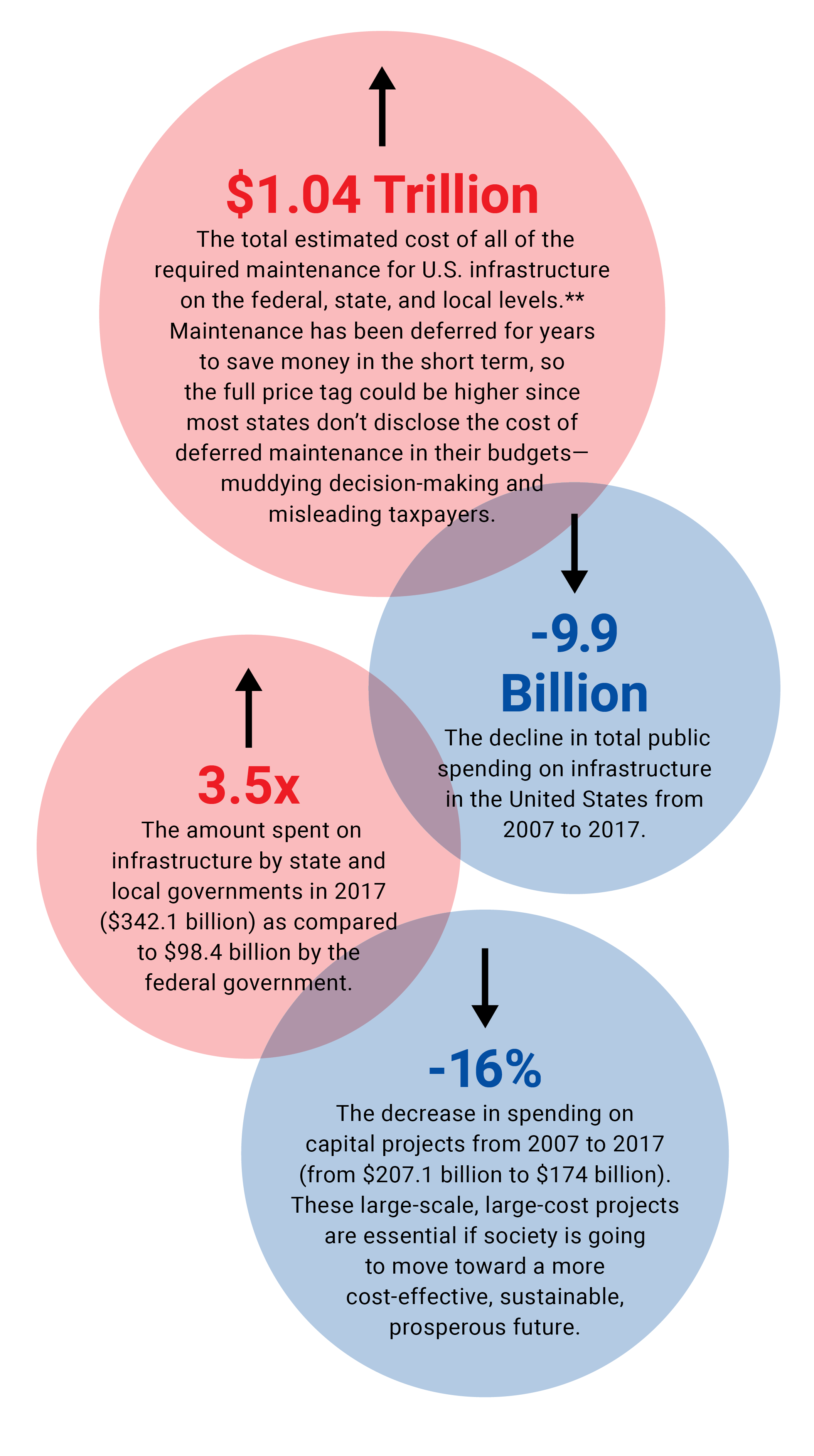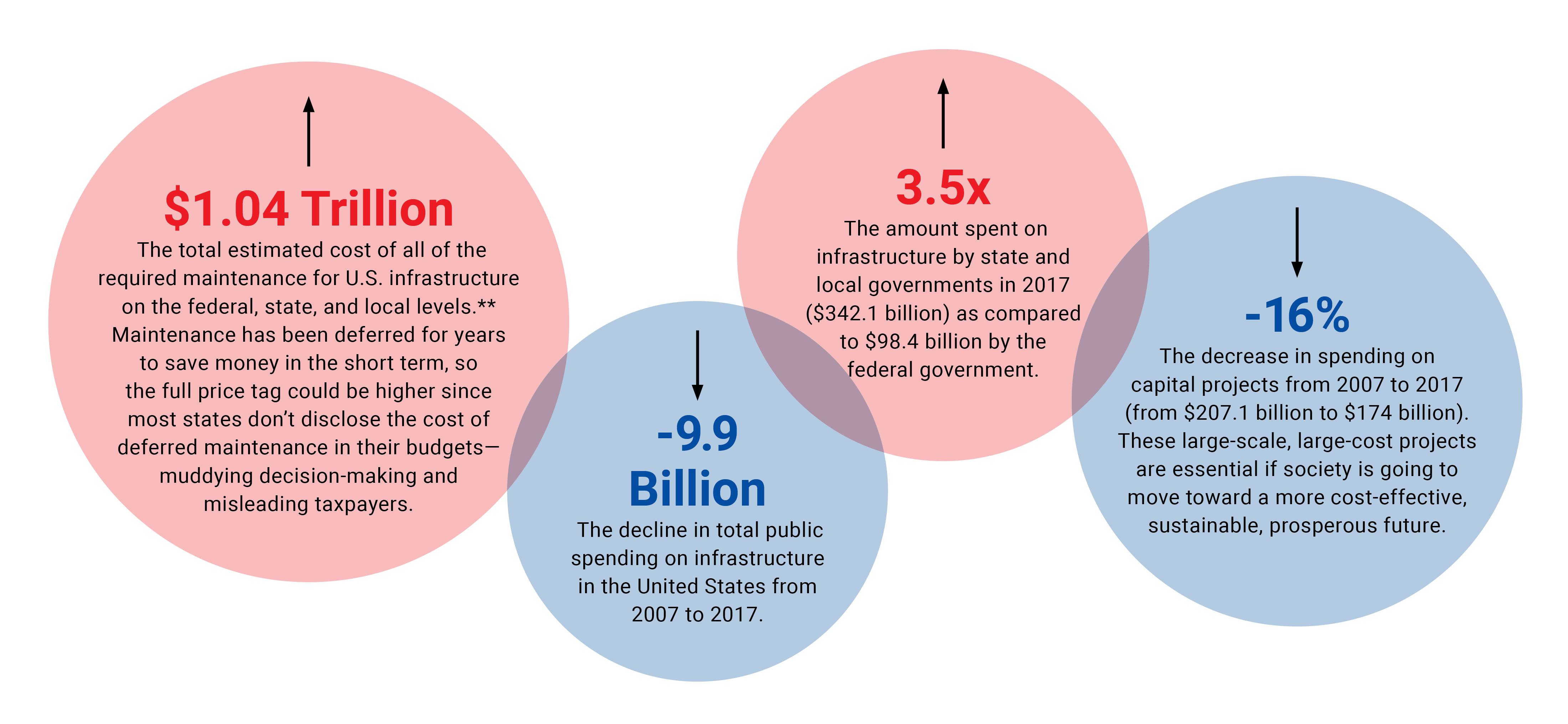Contents
Infrastructure Influences Everything
The history of mankind is the history of infrastructure.
It serves as the connections that bind us and lift us up, from the aqueducts of Rome to Thomas Edison’s telegraph lines to the 5G networks of today. It’s cellular networks and satellite arrays. It’s also access to the internet, digital commerce, and tools for social interaction. When designed and governed properly, infrastructure is seamless—empowering people, companies, and governments to prosper. But when it’s designed poorly, it can literally divide us.
Ultimately, the way we build and maintain our infrastructure will shape our future—and now is a pivotal moment for doing so. To solve issues as urgent as racial injustice, income and wealth inequality, and climate change, we must begin by rethinking our infrastructure.
To do this, we must first recognize that our infrastructure is multidimensional—that our physical, digital, and social realms are equally important for ensuring opportunity for all.
How Innovations Become Infrastructure
Novel technologies often become essential to everyday life—and influence the outcomes of everyone in a society. Here are just three examples.

Roman Aqueducts
The Roman Empire, using tax dollars, constructed hundreds of aqueducts to bring water into its cities, where the water supplied free public baths, fountains, and even some private residences. Mining, milling, and farming operations also used this water, which helped to create a thriving economy.

Railroads
In the 19th century, most trains were privately owned and operated on gauges (the width of the tracks) that were unique to each company. This meant that one train couldn’t run on another company’s track. Corporations and the government worked to resolve this incompatibility by standardizing gauges, helping to unleash the full potential of the new technology.

Telephone Lines
At first, telephones (and electricity) were a luxury. But the technology soon became critical infrastructure, as more and more people relied on it for their basic method of communication, and the government incentivized companies to expand service across the U.S. by offering low-interest bonds, among other things.
It’s Time for a New Definition of Infrastructure
There’s a better way of viewing and assessing the underlying structures of society.
Today, the challenges facing infrastructure are vast. According to the nonprofit Volcker Alliance, the United States has a trillion-dollar backlog in deferred maintenance costs, and spending on infrastructure has declined by nearly $10 billion from 2007 to 2017. Failing to update the nation’s deteriorating infrastructure hinders both businesses and struggling citizens. According to a report by the American Society of Civil Engineers, the economy could lose $4 trillion in GDP by 2025 if these funding gaps are not addressed. Two and a half millions jobs could be lost.
But with these challenges also comes opportunity. If infrastructure is going to succeed, we must consider it in a new way—one that reflects the constantly changing nature of our world and more broadly encompasses the key drivers of society: physical, social, and digital systems. For decades, the physical, digital, and social dimensions of infrastructure have typically been treated as separate issues, leading to siloed thinking and short-term solutions. But infrastructure doesn’t act that way in the real world. For instance, a library is not just a storage facility for books. It’s a physical place that forges community bonds and offers digital access. Similarly, a road is not just a paved surface for vehicle traffic. It’s a vital artery for commerce and social connections, one that is now governed as much by digital systems like Google Maps and Waze as individual drivers. Or consider this: When you post a photo to Instagram or comment on Twitter, you’re relying on a vast network of physical structures like cell towers, transatlantic cables, and server farms, as well as invisible structures like radio signals, network protocols, and machine coding.
The reality is that the infrastructure reinforcing today’s society is multifaceted and interdependent. Think of this as a three-legged stool: Should any leg falter or be cut off, it will topple the person sitting on it. By recognizing the interconnection of all three dimensions, we can use this new framework to better design infrastructure systems for the future, strengthen communities, and power economic activity in the process.
The Decline of Infrastructure Investing
Public investment in infrastructure is at the lowest it’s been in decades, creating a backlog of maintenance, crumbling structures—and a limited appetite for tackling necessary projects for the future.


Click labels to see more details
Multidimensional Infrastructure in Action
Three case studies that demonstrate the power of a holistic approach.
Creating a new vision for infrastructure is difficult, but we’ve been here before.
During the Great Depression of the 1930s, the government’s massive New Deal program sparked one of the largest waves of investments in infrastructure in U.S. history: the Hoover Dam in Nevada, New York’s Lincoln Tunnel, Great Smoky Mountains National Park, and the sprawling Tennessee Valley Authority, to name a few. But the New Deal was designed to do more than create new transportation routes and produce cheap energy. It was designed to create jobs, uplift individuals and communities, and transform society as a whole by providing economic development to areas that needed it. “The New Deal integrated physical infrastructure with artistry and a sense of place,” says Michael Murphy, the CEO and founding architect of the firm MASS Design Group (an acronym for Model of Architecture Serving Society). “Today we should be doing the same thing. Instead of building fixed infrastructure systems, we should be constructing living systems—ones that adjust and calibrate to their physical and social environments.”
Multidimensional infrastructure, in other words, is designed with an ecosystem approach—one that elevates its environment and the people dependent on it, creating more resilient and equitable results for everyone. Going forward, we have the opportunity to reimagine infrastructure, ensuring that physical, digital, and social systems create more thriving communities.
Here are three case studies for how to do so.
1
Building Prosperity: The 21st-Century Library
How a public institution transformed from a repository of knowledge to the backbone of community—and economic—growth
Widely thought of as repositories of collective knowledge, libraries are now also hubs of civic engagement, providing free access to the internet, job training, art space, and even coffee shop culture. They are first and foremost physical places. But digital and social systems are embedded within them, giving locals free access to the online world to learn new skills. In Austin, for example, library staff members created a vocational class to teach welding so that out-of-work residents could retrain for high-paying jobs. In Houston, where 66 percent of adults and 34 percent of youth are overweight, library employees offered events to promote healthy eating and exercise and also distributed 50,000 pounds of fresh food to more than 3,100 families. In Omaha, Nebraska, library staff members even established a series of partnerships with regional software and technology companies to train residents in digital skills, helping to spark a local boom in tech workers. Libraries, in other words, are a prime example of the power of new, more holistic infrastructure.
The Power of Modern Libraries
How an ancient institution helps individuals and communities thrive through innovative programs anchored in a multidimensional approach
Click illustration to see more details
2
The Unexpected Areas Fueling a Surge in High-Tech Jobs
How tech infrastructure can revitalize rural America
Despite strides to improve online access, rural areas across the United States continue to struggle in the digital age. Just 25 American cities—high-growth hubs like New York, San Francisco, and Austin—have accounted for more than two thirds of job growth in the past decade. But some rural areas are bucking that trend, leveraging digital infrastructure to help to spur a revitalization. But it isn’t just the high-speed internet that is jump-starting economies. It’s also the social infrastructure built around it—the spaces for tech or software businesses to thrive, for programs to help train locals on coding and software development, and for the coffee shops, breweries, and small music venues to make those workers want to stay. In this way, the digital, social, and physical infrastructures are uniting to boost communities as a whole. “We have this joke,” says Matt Dunne, the executive director of the nonprofit Center on Rural Innovation, “that the real causes of rural economic development are the three Bs: broadband, blues music, and beer. Put all those good things together, and you can create the energy that will reverse the exodus of rural people from these places.”
Elevating Rural America
Small towns across the country are boosting their economies by pairing digital investments with social and physical infrastructure. Here are a few of the communities that the Center on Rural Innovation (CORI) is working with
Click illustration to see more details
3
The Future of Power
How a boundary-pushing start-up is rethinking energy
What if streets, roads, and sidewalks were more than just conveyor belts for cars and pedestrians? What if they became the building blocks for a futuristic city, embedded with technologies like power delivery systems, data-collecting devices, and information and communications technology (ICT)? These may seem like wild notions, but they’re the focus of Uncharted Power, a New York–based company leveraging an underutilized public asset—the ground we walk and drive on—to combine civil infrastructure with power grids and digital technologies.
The primary component of the Uncharted System, as the technology is called, are “pavers.” They’re essentially road and sidewalk panels designed to accommodate power lines and tech capabilities like ICT. Once deployed, the Uncharted System converts the ground beneath our feet (and our tires) into a multiuse space for electricity delivery, data technologies, and smart-city applications. The system can then be used for things like monitoring citizen safety, creating resilient electrical grids, and offering affordable broadband. It’s also easily upgraded as new technologies emerge. The Uncharted System, which the company is hoping to launch with a pilot program in Poughkeepsie in 2021, is a vision for how governments and private industries can solve energy and social problems in sustainable, equitable ways, ensuring the best interests of people and their data are at the center of it all.
Reimagining Electricity for a More Equitable Society
How the start-up Uncharted Power is disrupting the energy grid—and democratizing the future of electricity through a new infrastructure approach
Click illustration to see more details
The Power of multidimensional Infrastructure
Overall, each of these three examples—modern libraries, rural tech hubs, and Uncharted Power—have one thing in common: They’ve taken an ecosystem approach to creating smarter, more equitable infrastructure that accounts for physical, social, and digital dimensions. Once the problems are examined through a multidimensional lens, the solutions that come to the foreground are often naturally synergistic and create value across every dimension—whether that’s leveraging a relatively new technology, like the internet, to help revitalize communities or reimagining an old system, like the power grid, to create a more equitable and just society. Using a multidimensional framework to assess infrastructure challenges, in other words, is the most practical and effective way of arriving at the forward-looking solutions the United States needs.